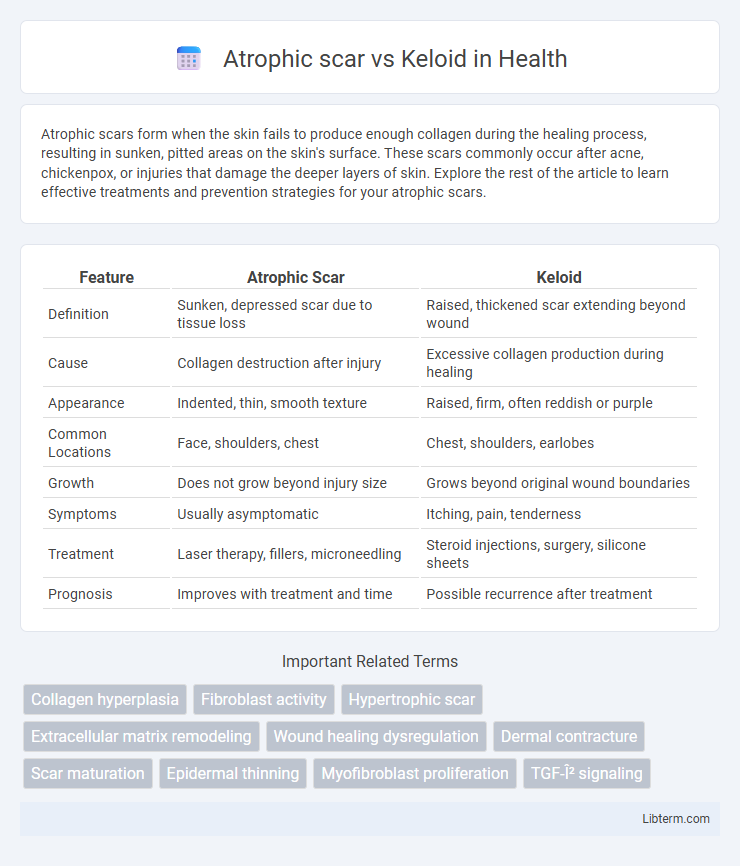Atrophic scars form when the skin fails to produce enough collagen during the healing process, resulting in sunken, pitted areas on the skin's surface. These scars commonly occur after acne, chickenpox, or injuries that damage the deeper layers of skin. Explore the rest of the article to learn effective treatments and prevention strategies for your atrophic scars.
Table of Comparison
| Feature | Atrophic Scar | Keloid |
|---|---|---|
| Definition | Sunken, depressed scar due to tissue loss | Raised, thickened scar extending beyond wound |
| Cause | Collagen destruction after injury | Excessive collagen production during healing |
| Appearance | Indented, thin, smooth texture | Raised, firm, often reddish or purple |
| Common Locations | Face, shoulders, chest | Chest, shoulders, earlobes |
| Growth | Does not grow beyond injury size | Grows beyond original wound boundaries |
| Symptoms | Usually asymptomatic | Itching, pain, tenderness |
| Treatment | Laser therapy, fillers, microneedling | Steroid injections, surgery, silicone sheets |
| Prognosis | Improves with treatment and time | Possible recurrence after treatment |
Understanding Atrophic Scars
Atrophic scars are characterized by a sunken or depressed appearance caused by the loss of underlying tissue, commonly resulting from acne, chickenpox, or physical trauma. Unlike keloids, which are raised and extend beyond the original wound boundaries due to excessive collagen production, atrophic scars involve collagen deficiency and skin thinning. Effective treatments for atrophic scars include microneedling, laser therapy, and dermal fillers aimed at stimulating collagen regeneration and restoring skin volume.
What Are Keloid Scars?
Keloid scars are raised, thickened areas of skin that extend beyond the original wound boundary due to excessive collagen production during the healing process. Unlike atrophic scars, which are sunken or depressed, keloids are characterized by their firm texture and continuous growth beyond the injury site. Commonly triggered by skin trauma, surgical incisions, acne, or burns, keloid scars often cause itching, pain, and cosmetic concerns.
Key Differences: Atrophic Scar vs Keloid
Atrophic scars appear as sunken or depressed skin due to tissue loss, commonly resulting from acne or chickenpox, whereas keloids are raised, thickened scars that extend beyond the original wound boundaries caused by excessive collagen production during healing. Atrophic scars typically have a softer texture and can improve with treatments like microneedling or laser therapy, while keloids are firm, itchy, and often require corticosteroid injections or surgical removal. The primary differentiation lies in their formation process: atrophic scars result from inadequate collagen, whereas keloids arise from abnormal collagen overgrowth.
Causes of Atrophic Scars
Atrophic scars result from collagen and elastin loss during the healing process, often due to conditions like acne, chickenpox, or trauma that damage the dermis layer. Unlike keloids, which are caused by excessive collagen production leading to raised scars, atrophic scars form depressions or indentations in the skin. Factors such as genetic predisposition, delayed wound healing, and inadequate skin regeneration contribute significantly to the development of atrophic scars.
Causes and Risk Factors for Keloids
Keloids form due to an overproduction of collagen during wound healing, often developing after skin injuries like surgery, burns, or acne. Genetic predisposition plays a significant role, with higher risk observed in people with darker skin tones, such as individuals of African, Hispanic, or Asian descent. Other risk factors include age (commonly occurring between 10 and 30 years old), skin tension at the injury site, and repeated trauma, which all contribute to abnormal scar tissue growth distinguishing keloids from atrophic scars.
Appearance and Texture: How to Identify Each
Atrophic scars appear as sunken or depressed areas on the skin due to collagen loss, often presenting with a thin or fragile texture. Keloids exhibit raised, thickened growths that extend beyond the original injury site, characterized by a firm, rubbery surface. Identifying each involves assessing scar elevation and texture--atrophic scars are concave and soft, whereas keloids are convex and dense.
Diagnosis Methods for Scarring Types
Atrophic scars are diagnosed primarily through clinical examination, identifying depressed or sunken areas with thin, stretched skin, often resulting from acne or injury. Keloids are recognized by their raised, thickened, and fibrous nodules extending beyond the original wound boundaries, confirmed by physical assessment and sometimes biopsy to rule out hypertrophic scars. Advanced imaging techniques like ultrasound or dermoscopy assist in differentiating scar depth and vascularity, enhancing diagnostic accuracy between atrophic scars and keloids.
Treatment Options for Atrophic Scars
Atrophic scars, characterized by depressions or indentations in the skin, often respond well to treatments like microneedling, laser therapy, and chemical peels, which stimulate collagen production. Topical treatments containing retinoids or silicone gel can also improve skin texture and appearance by promoting skin regeneration. Unlike keloids, which require corticosteroid injections or surgical removal due to excessive tissue growth, atrophic scars benefit most from therapies aimed at enhancing skin repair and volume restoration.
Keloid Scar Management and Prevention
Keloid scars result from an overproduction of collagen during the skin healing process, leading to raised, thickened scars that extend beyond the original wound boundary. Effective keloid scar management includes intralesional corticosteroid injections, silicone gel sheets, laser therapy, and in some cases, surgical excision combined with postoperative radiotherapy or pressure therapy to minimize recurrence. Prevention strategies emphasize early wound care, avoiding unnecessary skin trauma, and using topical treatments such as silicone-based products or silicone sheets to promote proper healing and reduce keloid formation risk.
Choosing the Right Treatment for Your Scar Type
Atrophic scars result from tissue loss causing depressions, while keloids form from excessive collagen growth, leading to raised, thick scars. Choosing the right treatment depends on scar type: atrophic scars respond well to dermal fillers, microneedling, and laser therapy, whereas keloids often require corticosteroid injections, silicone sheets, or surgical removal combined with radiation therapy. Accurate diagnosis by a dermatologist ensures targeted treatment that minimizes scar visibility and prevents recurrence.
Atrophic scar Infographic

 libterm.com
libterm.com